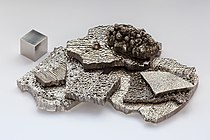Group 9 element
| Group 9 in the periodic table | |||||||||
|---|---|---|---|---|---|---|---|---|---|
| |||||||||
| ↓ Period | |||||||||
| 4 |  27 Transition metal | ||||||||
| 5 |  45 Transition metal | ||||||||
| 6 |  77 Transition metal | ||||||||
| 7 | Meitnerium (Mt) 109 unknown chemical properties | ||||||||
|
Legend
| |||||||||
Group 9 is a group (column) of chemical elements in the periodic table. Members are cobalt (Co), rhodium (Rh), iridium (Ir) and meitnerium (Mt).[1][page needed] These are all transition metals in the d-block.
Like other groups, the members of this family show patterns in electron configuration, especially in the outermost shells, resulting in trends in chemical behavior; however, rhodium deviates from the pattern.
"Group 9" is the modern standard designation for this group, adopted by the IUPAC in 1990.[1]
In the older group naming systems, this group was combined with group 8 (iron, ruthenium, osmium, and hassium) and group 10 (nickel, palladium, platinum, and darmstadtium) and called group "VIIIB" in the Chemical Abstracts Service (CAS) "U.S. system", or "VIII" in the old IUPAC (pre-1990) "European system" (and in Mendeleev's original table).
Chemistry[]
| Z | Element | No. of electrons per shell |
M.P. | B.P. | Year of Discovery |
Discoverer |
|---|---|---|---|---|---|---|
| 27 | cobalt | 2, 8, 15, 2 | 1768 K 1495 °C |
3200 K 2927 °C |
~1735 | Georg Brandt |
| 45 | rhodium | 2, 8, 18, 16, 1 | 2237 K 1964 °C |
3968 K 3695 °C |
1803 | W. H. Wollaston |
| 77 | iridium | 2, 8, 18, 32, 15, 2 | 2719 K 2446 °C |
4403 K 4130 °C |
1803 | S. Tennant |
| 109 | meitnerium | 2, 8, 18, 32, 32, 15, 2[*] | — | — | 1982 | P. Armbruster and G. Münzenberg |
[*] Predicted.
The first three elements are hard silvery-white metals:
Cobalt is a metallic element that can be used to turn glass a deep blue color.
Rhodium can be used in jewelry as a shiny metal.
Iridium is mainly used as a hardening agent for platinum alloys.
All known isotopes of meitnerium are radioactive with short half-lives. Only minute quantities have been synthesized in laboratories. It has not been isolated in pure form, and its physical and chemical properties have not been determined yet.
See also[]
References[]
- Groups (periodic table)